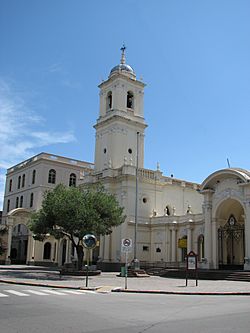Cathedral Basilica of the Holy Saviour, San Salvador de Jujuy facts for kids
Quick facts for kids Cathedral Basilica of the Holy Saviour |
|
|---|---|
| Catedral Basílica de San Salvador de Jujuy | |
 |
|
| 24°11′07″S 65°18′13″W / 24.1852°S 65.3036°W | |
| Location | San Salvador de Jujuy |
| Country | Argentina |
| Denomination | Roman Catholic Church |
The Cathedral Basilica of the Holy Saviour is a famous Roman Catholic church in the city of San Salvador de Jujuy, Argentina. In Spanish, its name is Catedral Basílica de San Salvador de Jujuy. It is an important and historic building for the whole country.
Because of its history and beauty, the cathedral was named a National Historical Monument in Argentina on May 16, 1931. This special title helps protect the building for future generations to enjoy.
History of the Cathedral
The cathedral you see today is a beautiful example of Spanish colonial style from the 1700s. Before this building, several other churches stood in the same spot. However, they were built with weaker materials and did not last very long.
By 1736, the previous church was no longer safe to use. So, people began building the strong and beautiful cathedral that exists now. We don't know the exact date it opened, but historians believe it was between 1761 and 1765. Over the years, some small changes were made to the building.
A Role in Argentina's History
This cathedral played a big part in Argentina's fight for independence. On May 25, 1812, the new flag of Argentina was blessed here for the first time. The flag was created by a famous leader named Manuel Belgrano.
After the blessing, soldiers and citizens gathered outside. They promised to be loyal to the new flag and the cause of freedom. A famous painting inside the cathedral shows this important moment. The painting was made by an artist named Luis De Servi to celebrate the 100th anniversary of the event.
Religious Importance
The cathedral is also a special place of worship. It holds a statue called Our Lady of the Rosary of Paypaya and White River. In 1812, this statue was named the "Patron of the Armies of the North." This means she was seen as a special protector of the soldiers who fought for Argentina's freedom.
See also
 In Spanish: Catedral Basílica de San Salvador (San Salvador de Jujuy) para niños
In Spanish: Catedral Basílica de San Salvador (San Salvador de Jujuy) para niños
- Roman Catholicism in Argentina
- Holy Saviour


